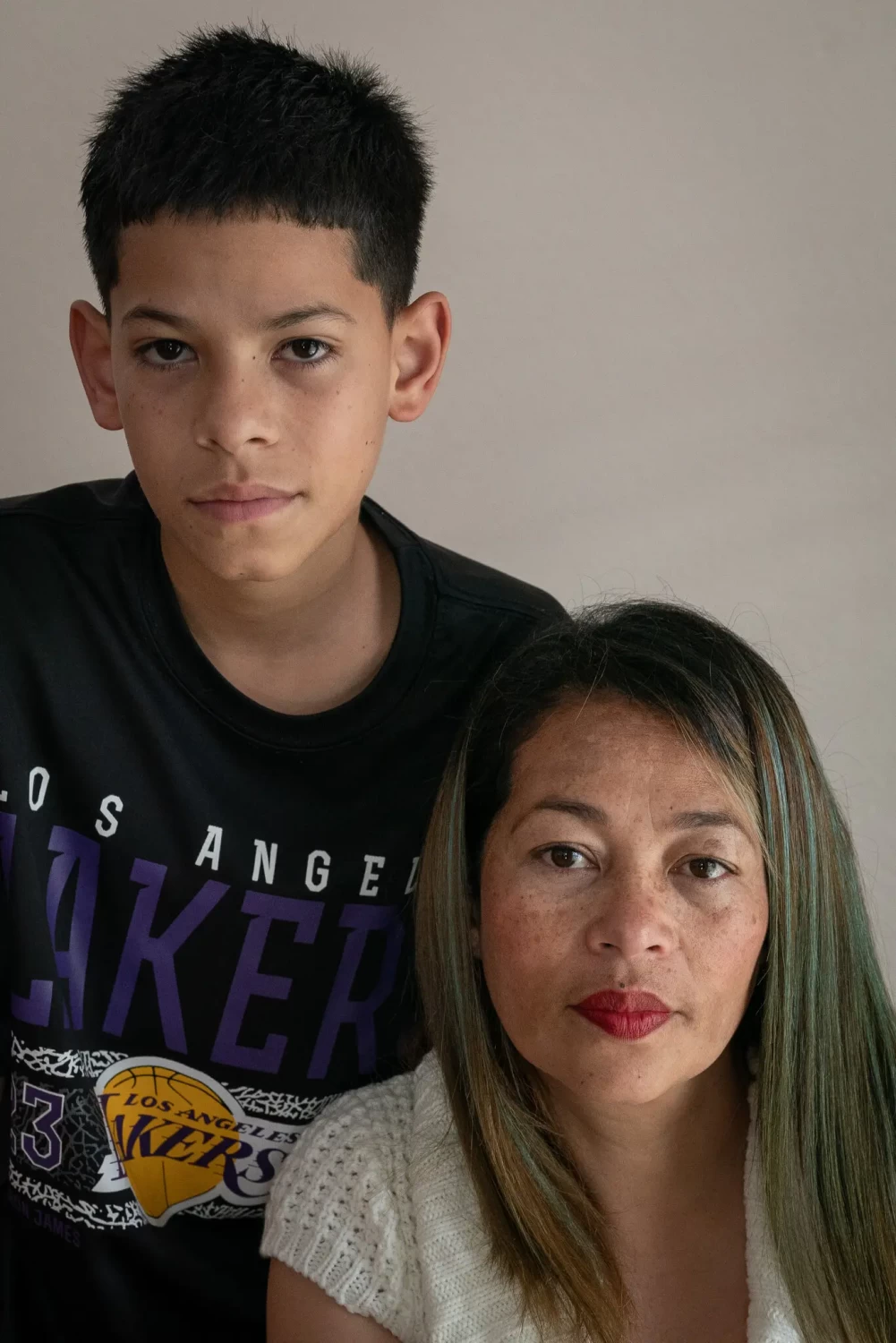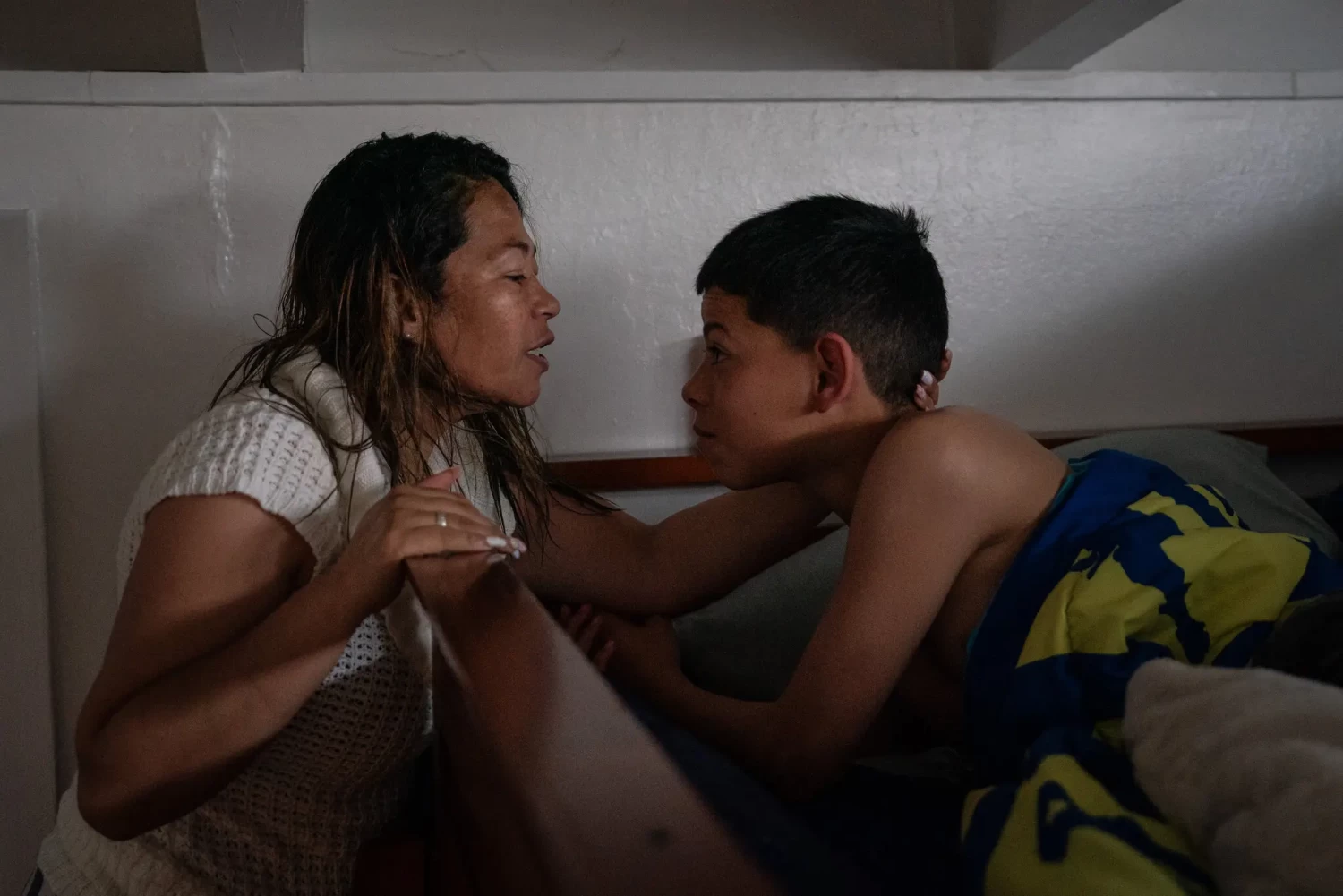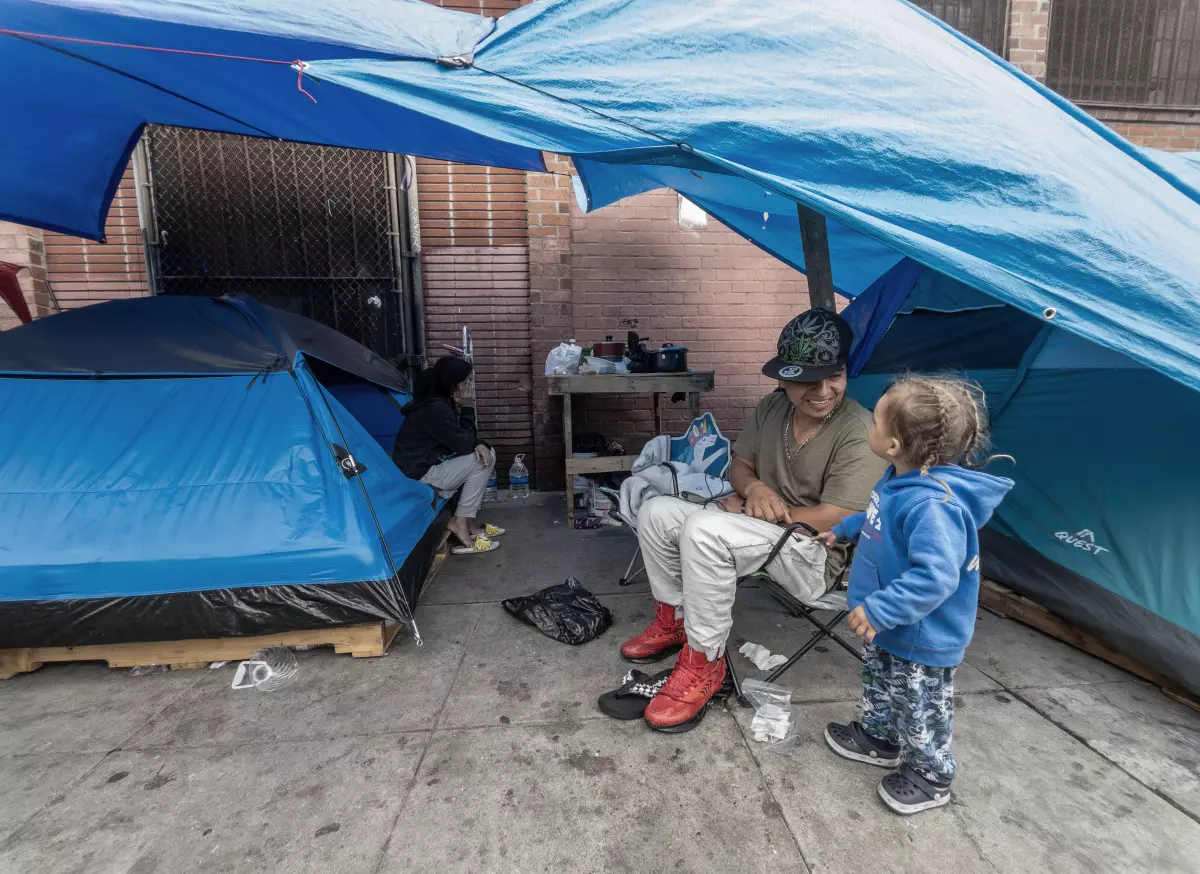Ankle Monitors and Curfews: Inside Biden’s New Tracking System for Migrant Families

On a recent evening in California, a woman named Sandra was at a birthday party with her 15-year-old son when she glanced at the clock.
She started to panic: It was after 10 p.m.
She had less than an hour to get home in time for an 11 p.m. curfew set by U.S. immigration authorities, part of a nearly year-old tracking system for migrant families who hope to be granted asylum in the United States.
She motioned to her son that they had to leave, and hustled him out the door and into the car.
They made it home at 10:58 p.m., the bulky GPS monitor on her right ankle pinging out her location to the authorities keeping track. Her heart, which had been slamming in her chest the whole ride home, finally slowed.
Sandra, 45, and her son Justin, who crossed the border in December after fleeing Colombia, are part of a nearly year-old Biden administration program that seeks to quickly process — and potentially deport — many of the migrant families who have arrived in the United States in record-breaking numbers.
The goal of the program is to keep families from skipping out on their asylum hearings and melting away into American society, joining the millions of undocumented people who stay in the country indefinitely under the radar of U.S. authorities.
If the families fail their asylum screenings, they can be deported within weeks. The asylum process usually takes years, with most claims ultimately rejected.
So far, the Family Expedited Removal Management program has tracked more than 19,000 people since May, according to data from U.S. Immigration and Customs Enforcement that was obtained by The New York Times. More than 1,500 of them have been deported and around 1,000 have absconded by prying off their ankle monitors, the ICE data show. The rest either passed their initial screenings or still have cases underway.
Although the program has been used in only a fraction of claims, some U.S. officials see it as a test case for a faster way to deal with families seeking refuge in America, where laws require the government to consider asylum claims from anyone who makes it onto U.S. soil.
They hope the program can provide an alternative to the usual options for handling migrant families: detaining them in costly ICE facilities, which President Biden has criticized, or releasing them with court dates years in the future and no consistent way of tracking them.


Thomas Giles, an ICE official who runs the program, said it was showing signs of promise.
“It’s definitely increased our family unit removals over the last nine months compared to before, so it’s been successful with that,” he said. But he cautioned that the program requires an enormous amount of resources and is still in the early days.
“This is basically what we’ve needed to do for 10 years, but on a massive scale,” said John Sandweg, who was acting director of ICE during the Obama administration.The Biden administration should expand the program, he said, because it is difficult to deport people — especially families — once they have been in the United States for years, building lives in America while their cases wend their way through the system.
What to do with families?
The U.S. immigration system, chronically underfunded and understaffed, cannot keep pace with the number of people who want asylum in America. Mr. Biden, in an election year with immigration as a dominant issue, is even said to be considering restricting asylum altogether.
There were more than 2.5 million migrant encounters at the southwest land border in fiscal year 2023, a record-breaking number that has strained resources in American cities.
The questions of how, where and how long to detain migrants have confounded successive administrations. But the issue of what to do with families, in particular, has been among the most fraught, with ethical and political implications at every turn.
Years of scientific consensus show that detaining minors, even with their parents, can cause developmental damage. Presidents George W. Bush, Barack Obama and Donald J. Trump all detained families in ICE facilities, hoping that the prospect of being locked up would deter migrant families from making the trip.

Mr. Trump tried to expand the practice and detain families indefinitely, but a federal judge said it violated a court settlement that required that families only be detained for 20 days.
The Biden administration made a point of ending family detention, instead releasing families with ankle bracelets and traceable cellphones. That model was a precursor to the new program, which uses strict curfews and expedited asylum screenings in addition to the electronic monitoring.
The program is being used in more than 40 locations with the resources to keep track of thousands of migrants and make swift rulings in a make-or-break step of the asylum process: the credible-fear interview.
In a functioning system, most people seeking asylum would be interviewed at the border to determine whether they have a credible fear of persecution back home. But only about 500 such interviews are conducted every day — for a sliver of the thousands of people who cross.
The rest are often released into the country with a court date far in the future.
The new program aims to screen families and quickly deport those who don’t meet the bar for credible fear. Mr. Giles, the ICE official who runs the program, said that ICE gives migrants a list of free legal service providers when they are processed into the program.
If families fail their initial screenings, case managers who track their movements make sure their travel documents are in order and coordinate the trips home, usually on chartered government planes. If they abscond, ICE begins to search for them for immediate arrest.
If they pass, they can stay in the United States at least until their cases are concluded.
‘I didn’t want to come’
Sandra said she came to the United States as a last resort.
For years in Colombia, she ran a Christian organization aimed at helping the children of people addicted to drugs. It was, she said, her “dream job.”
But last year, she said, gang members threatened to kill her because she refused to help them sell drugs. She knew she had to leave.
“I didn’t want to come,” she said through a Spanish interpreter, asking that only her first name be used because of fears for her safety. “Many people come here because they are after the famous American dream — but that was not my case.”
In Colombia, she said, she was “up here,” motioning above her head. In America she is “down here,” pointing to her ankle monitor.
She began organizing the journey to the United States in the winter, with a vague plan for what to do once she arrived with Justin: Her older son, who had come to the United States a few years ago, would buy them plane tickets to Oakland, Calif.
But first she had to get across the border. In Mexico, they were robbed and threatened with kidnapping and torture. Cartel members threatened to hold them until their families paid money. There was only one option, she said. Cross the border.


Sandra says she knew she had to leave Colombia when gang members threatened to kill her because she refused to help them sell drugs.Credit...Loren Elliott for The New York Times
In early December, they walked into Arizona and told Border Patrol they were afraid to return to Colombia, kick-starting the asylum process.
The government saw them as candidates for the new expedited process because they were headed to the Bay Area, where the program has an office. Sandra was given an ankle monitor and told to check in at a government office in San Francisco.
The case manager there told Sandra that she was not a criminal but that this was part of Mr. Biden’s program to get things “under control,” she recalled.
“This is kind of humiliating in a way,” she said. “We know that we didn’t come here legally, but we didn’t have a way to do it legally.”
‘Completely untenable’
Many advocates for immigrants say the expedited removal program actually works too fast, making it difficult for people to find legal representation. They also criticize the use of GPS trackers, which are more often used in criminal courts.
The National Immigrant Justice Center said building an asylum case requires “complex legal research, fact gathering, and numerous in-person meetings with the client for trauma-informed interviews and case preparation.”
“The speed of the program is completely untenable,” said Cindy Woods, national policy counsel at Americans for Immigrant Justice, an organization that represents families whose cases are processed through the expedited removal program, including Sandra’s.

Ms. Woods said that over the summer, a mother of two from Ecuador reached out to her two days before her family’s credible-fear screening. But the woman became distraught when talking about “past harm and threats,” Ms. Woods said.
There was no time to prepare her for the asylum screening, which she ultimately failed, Ms. Woods said. The woman is now in hiding with her family in Ecuador.
Ms. Woods said the expedited removal program was preferable to family detention. But she said “it is happening way too fast.”
For the Biden administration, speed is the whole point.
The backlog in the immigration courts surpassed three million cases last year, and there are not nearly enough judges and interpreters to tackle it effectively. The new expedited program is an attempt to keep that backlog from swelling even more with families.
The future
On a Friday in late December, Sandra arrived at her initial asylum screening in San Francisco.
She explained to the officers why she had come to the United States and what she risked back home. One week later, there was a decision: She had passed the credible fear screening, the first administrative step on the road to asylum.
She had been in America for four weeks.
Now, she waits along with the rest of the asylum seekers for her case to come up in immigration court. There are often multiple hearings, including one where both the migrant and the government present evidence. That can take years.
Now that she’s passed the initial screening, government officials took off her ankle bracelet — a relief, she said. She will apply for a work permit so she can earn money.
But the country still feels deeply unfamiliar to her.
“We trust in God and I think everything is going to turn out well,” she said. “But of course we are afraid of what is going to happen.”

Hamed Aleaziz covers the Department of Homeland Security and immigration policy. More about Hamed Aleaziz
Keywords
Newer articles




